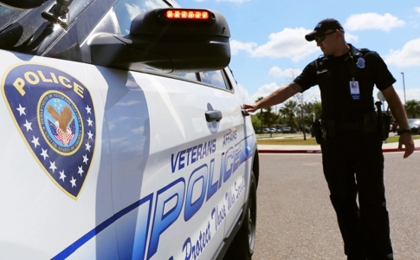
VA facilities have had problems with security incidents, and staff shortages among police offices has exacerbated the problems. VA photo
WASHINGTON, DC — By their nature, VA healthcare facilities are meant to be easily accessible, but open-campus layouts also make them difficult to secure. A recent report shows that this challenge has been exacerbated by understaffed police forces, inoperable cameras and unlocked and unguarded entrances.
In fiscal year 2022, VA recorded 36 separate serious incident reports at 32 different facilities. Serious incidents cover matters such as major theft, harm to people or VA property, use of police firearms or shootings and other severe disruptions of operations. One of the incidents was a bomb threat that resulted in the evacuation of the facility.
Last year, an Office of the Inspector General (OIG) team examined 70 VA facilities and found that a high number had significant security lapses. The average rate of vacant police officer positions at these facilities was 33%, with some reaching as high as 60%. This spread the existing police force too thin to cover all of their responsibilities.
While VA guidance states that there should always be at least two VA police officers on duty, 21% of employees surveyed at these facilities said they were aware of a duty shift during which those minimums were not met.
In 2018, 52 VA facilities reported a severe shortage of police. By 2022, that number had risen to 62 facilities. Some facilities reported using overtime to mitigate staffing shortages, and some made overtime mandatory. Even then, gaps remained.
“Facilities cannot always cover all their responsibilities, such as providing a security presence at public doors and emergency departments; patrolling; or providing security for veterans, visitors, and staff,” the OIG report stated.
In May 2022, VA issued guidance requiring that, by May 2023, facilities have an active security presence in emergency departments 24 hours a day, seven days a week. While facility directors still had several months left at the time of the investigation, OIG teams noted that 58% of emergency departments did not yet have a visible security presence.
“About 37% of survey respondents expressed concerns about the physical security at their facilities, some noting the lack of VA police on duty would sometimes make it difficult to respond to threats like an active shooter,” the report stated.
VA recently developed a police staffing tool to help determine appropriate officer levels at facilities, but there has not been enough time since implementation for OIG to determine whether it works.
The problems did not stop with the human element of facility security. Electronic and mechanical security measures were lacking as well.
Based on interviews with security personnel, the OIG found that 19% of all cameras were nonfunctional, with 24 facilities having more than 20% of their cameras not working.
At one facility, security personnel reported that they could not access the monitoring system, because “the required security certificates had expired, and no one knew the administrative password.” If that system went offline, no one could fix the problem without password access. Neither the VA’s Office of Information Technology nor the contractor for the facility’s cameras could override the administrative password.
Even if all cameras were operable, the police staffing shortage could impact their usefulness. The number of cameras could result in a large amount of footage to review, and many facilities might not have the personnel available to do it.
The OIG teams also found that 87% of public doors did not have an active security presence and, of those, 23% did not have a security camera. Additionally, 17% of nonpublic doors were unlocked; 97% of these unlocked doors did not have a security presence and 43% did not have a security camera.
Sometimes these doors led into sensitive or restrictive facility areas. At one facility, an unlocked, nonpublic access door led to the surgical intensive care unit.
The OIG had several recommendations to help VA improve its facility security, including delegating an official to be responsible for monitoring VA facilities security-related vacancies, direct VISN police chiefs to present a plan to remedy security weaknesses and standardize the review and retention requirements for facility security camera footage. The report also recommends that VA authorize sufficient staff to inspect VA police forces—a recommendation that OIG first made in 2018 and that went unimplemented.

